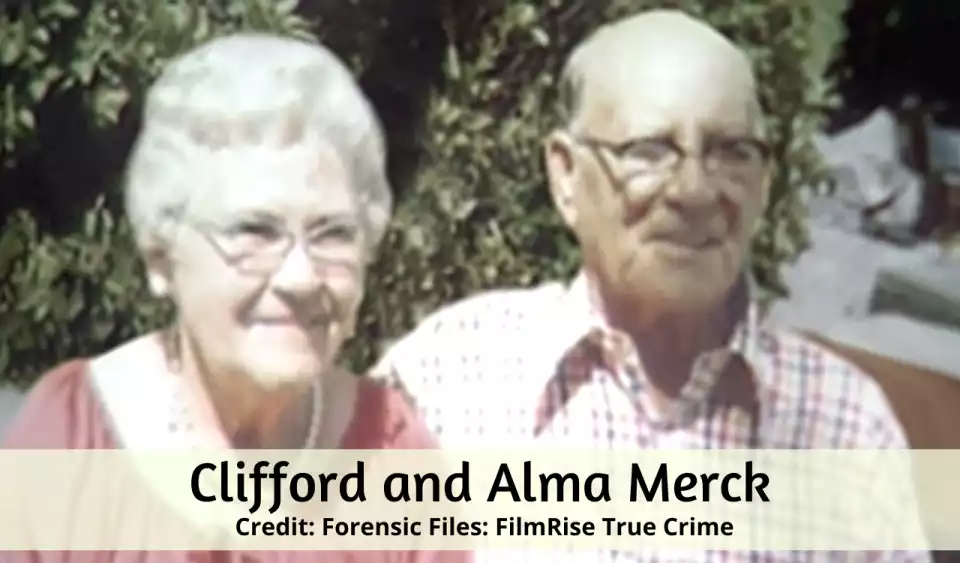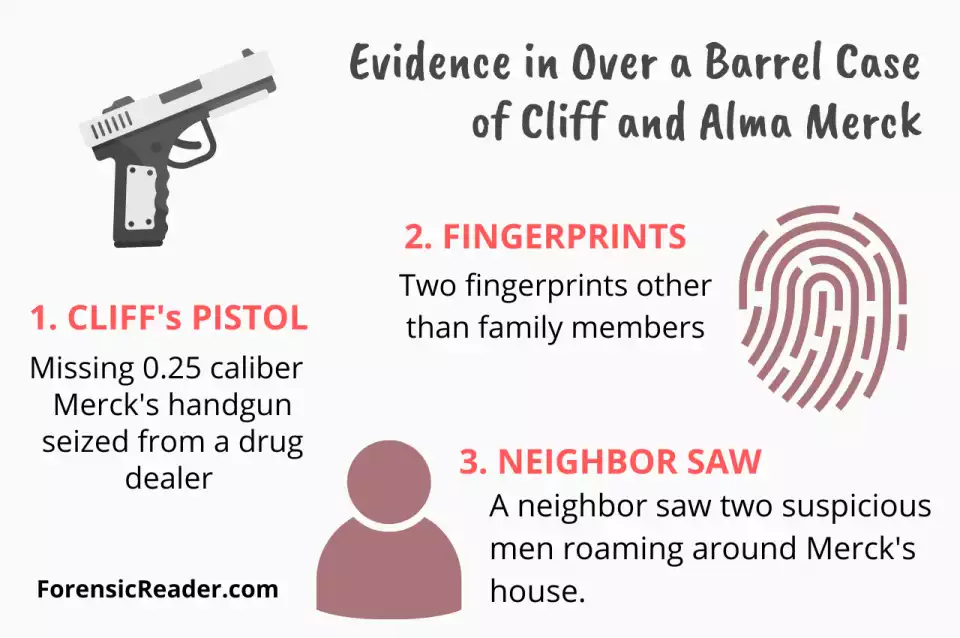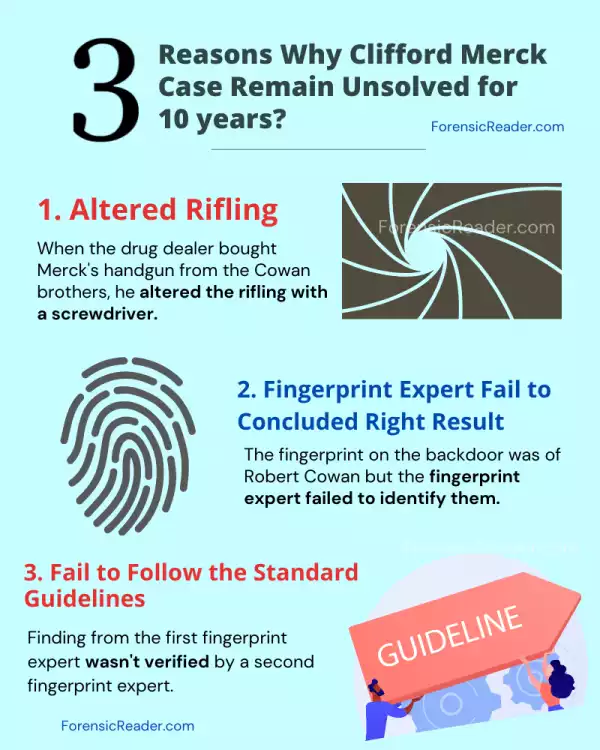Clifford and Alma Merck’s “Over a Barrel” Forensic file case remained unsolved for nearly a decade just because of incompetent forensic analysis and set Robert Wesley Cowan behind bars.
In this short case study, I a going to state how forensic experts’ reports shape the investigation. How did it affect Merck’s case of 1984? How it was finally solved with re-examination with an exceptionally new tool of forensic odontology.
Summary of Over a Barrel Case of Cliff and Alma Merck
Clifford Merck (75) and Alma Merck (81), a retired couple, lived in Bakersfield, California. On Saturday morning, September 4, 1984, Robert (their son) and his wife paid the couple a visit and suspected something was wrong with the place. The back door was open, and the house had a foul odor.

Robert called the Police, and sheriff, Jim Christopherson came to investigate. Jim discovered the house ransacked and everything turned upside down. At first, it seems like a typical robbery. But, Cliff Merck was found dead in the couple’s bedroom, his hands tied with cords and shot twice in the head.
Investigator also found a pillow with two bullet holes, which was used to muffle the gunfire sound. Alma Merck was discovered dead in another bedroom’s wardrobe, strangled with a telephone cord around her neck.
While searching for evidence, police found four main tips: (1) two fingerprints other than from the family member, (2) a 0.25 caliber handgun with Merck’s initial was missing, (3) a neighbor told investigators about the two suspicious men roaming around Merck’s house, and (4) pathologists later recovered two 0.25 caliber bullets from Cliff’s skull.
After two months, police recovered weapons of crime from Dan Jones, a drug addict, and dealer. Jones told the police that he got the gun from Robert Cowan. On investigation, police found that Rober’s brother Gerald Cowan may also be involved in the murder.

Other Evidences: In local pawn shops, police found Alma’s jewelry sold by the Cowan brothers. Police also found Cliff and Alma Merck’s belongings in Cowan’s possession, including a wallet, two social security checks, and jewelry.
Initial Forensic Analysis: Ballistic experts matched the land and grooves from Merck’s pistol recovered from Jones. But, it doesn’t match. All three sets of fingerprints (Jones and Cowan brothers) were also examined against the fingerprints found at Merck’s house, but none were matched.
Evidence not ample: All these evidences were only able to charge Cowan’s brother for stolen property, not murder. For nearly a decade, the case went cold and remained unsolved. After a decade, Jim Christopherson was promoted to the homicide department and he reopened the case.
During the re-investigation, Jim brought to know that there were several people present when the Cowan brothers sold the gun. According to one of them, Cowan told the dealer that the gun had been used in a crime. He also saw the dealer using a screwdriver to alter the pistol’s muzzle.
The evidence linked Robert Cowan and Gerald Cowan as the prime suspect. However, Gerald Cowan was released later because of no forensic evidence linking him to the murders of Clifford Merck and Alma Merck. Robert Cowan was sentenced to life imprisonment.

So Jim sent Merck’s gun for re-examination. The barrel’s rifling was re-examined using Mikrosil casting, which result in positive identification. Jim also sent the fingerprints to be compared to the prints of the Cowan brothers. This time, the prints matched, but only with Robert Cowan.
Evidence in the Over the Barrel Case (Robert Wesley Cowan)
| S.No. | Evidence | Location |
| 1 | Fingerprint -1 | A latent fingerprint lifted from the back door, above the doorknob. |
| 2 | Fingerprint- 2 | A Latent fingerprint lifted from the bottom of a plastic serving tray. |
| 3 | Pistols | Cliff’s Colt .25 caliber automatic pistol with a two-inch barrel and Cliff’s initials on the handle. Recovered from a drug dealer. Sold by Robert Cowen. |
| 4 | Neighbor | Two suspicious men were seen lurking around Merck’s house a few days before the murder by a neighbor. He later confirmed that the men he saw resembled Robert and Gerald Cowen. |
| 5 | Jewelry- Pawn Shop | Alma’s Jewelry: a turquoise ring and some costume jewelry. |
| 6 | Items in possession of Robert Cowan | (1) Wallet, (2) Metal cigarette lighter cover with a “rain god” design on it, (3) A tooled leather wallet, (4) Alma’s other jewelry-including a pearl bracelet, a necklace watch, a diamond watch, and earrings. |
3 Reasons Why Clifford Mercks Investigation Remains Unsolved for 10 years?

There are three main reasons why the Merck couple’s murder remains unsolved for a decade:
1. Barrel’s Rifling Was Altered
When Merck’s firearm was apprehended from Jones, it was sent to a forensic expert to match whether it was the same weapon or not. The forensic ballistic expert concluded that it didn’t match the bullet from Clifford’s head.
However, the forensic expert did not consider that the rifling of the barrel might be altered. They didn’t state about alteration in the barrel.
So, how rifling of barrels was altered in Mercks Over the Barrel case? Using a screwdriver.
How rifling of barrels altered?
Riflings are the land and grooves inside the barrel of the firearm. Any tool that can cause striation to these lands and grooves can cause rifling to change. Tools such as screwdrivers and wrenches are the most commonly used for this purpose. These tools were throttled against the barrel’s rifling, which changes the land and grooves.
One important note: the altering tools work effectively if they are moved to the opposite sides of the rifling. In opposite direction, they cause maximum damage.
Altering land grooves not only changes the previous rifling marks but also adds new ones. This altogether, make it appear to be different from the original one. So, if the bullet passes through these modified barrels, it will have new striation marks that are nearly unidentifiable to the original ones.
This means that if the examiner did not check the barrel for alteration (which they didn’t), they may conclude a false result.
There is one similar case where the land and grooves were altered. Read More: Shoot to Thrill Case Study: Forensic Approach to Ken MacLennan’s Death
2. Fail to Identify Ridge Details
Fingerprints from Cliff Merck’s house were not fully ridged. They lack details and may be partial. They are hard to identify but still, it must be done with no marks of error. But in Merck’s case, forensic experts fail to do so.
As per the listing, Jerry Roper was the forensic fingerprint expert who concluded that none of the fingerprints from Mercks belonged to Dan Jones, Robert Cowan, or Gerald Cowan. However, it was proven to be false, and it became a case where forensic experts fail to do their job.
3. Fail to Follow the Standard Guidelines
Standard Guideline: Finding from one forensic expert must be confirmed by another expert from the same field. In the “Over a barrel” case, the finding from Roper wasn’t verified by a second fingerprint expert.
If the prints may be verified by another expert, then this case might be ended within a few months of trial.
How were Culprits of “Over a Barrel” Forensic File Case Caught?
Two main re-examination helps the case most: one is silicone casting material and the second is the fingerprint analysis.
1. Gun Barrel Marks with Mikrosil
After a decade, Greg Laskowski, a forensic scientist from Kern County Regional Criminalistics Laboratory, was assigned to re-examine Merck’s firearm. Through microscopic examination, he determined that the gun’s barrel was deliberately altered.
The damages were intended more towards the muzzle and the rear end (another side of the muzzle) still had intact land and grooves. He uses Mikrosil to capture those fine details.
Mikrosil— Forensic Casting Material
Mikrosil is a flexible silicone elastomer that was quite popular as a casting material for tool marks and firearm markings. It comes in a two-pack system: a base and hardener. Commercially, there are various types of Mikrosil products such as black, white, gray, and brown.
Read More: Forensic Casting Materials: How to Choose One For Different Surfaces?
He makes a Mikrosil paste and injects it inside the barrel. After 15 minutes, the paste solidify into thick gelatine which was then compared with land and grooves marks on the bullet. This time, the ridges on the bullets were matched to the rear part of the casting.
And it was the first time Mikrosil, a casting material was used in ballistic, to solve the case.
2. Fingerprints Finally Matched
Once Jim, the chief investigator, gets a positive match for the firearm, he wants to reassure the finding for fingerprints. He sent the fingerprints for re-examination. The re-examination was done by a superior fingerprint expert, Sharon Pierce.
This time, the fingerprints from the back door matched with the offender Robert Cowan, and the results were cross-checked with another examiner in the office.
Punishment for Culprits and Where They are Now?
- Robert Wesley Cowan: Convicted of two counts of first-degree murder, and sentenced to death for Alma Merck’s murder and a life sentence without the possibility of parole for Clifford Merck’s murder.
- Gerald Cowen: Arrested for murder but was released due to lack of evidence. He was later convicted of murdering his father-in-law and served two years in prison and was released on parole.
Quick Question and Anwer about Over a Barrel Case
What did the son first notice when he entered his parents’ house?
When Robert Merck and his wife entered his parent’s house on a Saturday morning, September 4, 1984, he saw the whole place was rancid and had a foul odor. The back door was also open. It seems like a robbery but he didn’t find their parents. So, he called the police.
Why was Cliff’s gun so easy to recognize? Who had stolen it?
Cliff preferred to etch his belongings with his initials. His gun (a .25 caliber pistol) was also etched with his initials “C” and “M” over the handle. It was not etched by a professional but Cliff himself. During the robbery, Robert Cowan used that gun to shoot Cliff and later sold it to Dan Jones, a drug dealer.
How was the bullet matched to the weapon?
To hinder the positive match, the drug dealer changed most of the rifling (land and grooves) marks with a screwdriver, but the original rifling marks on the rear end of the barrel remained intact. These marks were then captured using the silicone casting material Mikrosil and compared to rifling marks on the bullets from Cliff’s head.
How was the gun used to kill the Merck couple altered?
Cowan’s brother informed Dan Jones, the drug dealer, that the gun had been used in a crime. He took the gun and inserted a screwdriver down the barrel, twisting it out and grinding the rifling marks that changes the original marks.
What material was used to make the casting of the barrel?
Mikrosil is a silicone casting material that was originally used in forensic odontology but after Merck’s case, it was quite popular in catching details over metal surfaces. It comes in a two-pack system: a base and hardener which sets in 15 minutes.
Why didn’t the fingerprints match initially?
Three main reasons: (1) fingerprints were partial and lack of details that makes comparison difficult; (2) Jerry Roper, the initial fingerprint analyst, fails to identify the common ridge details; and (3) Violation of standard protocol: findings from one forensic expert must be verified by a second expert, but in this case, no second opinion was made.
Read More:
- Shoot to Thrill Case Study: Forensic Approach to Ken MacLennan’s Death
- The DC Sniper’s Trail Case Study: Forensic Files, Evidence, and Culprits
- Magnetic Powders: Types, Principle, Fingerprint Development, Advantages And Disadvantages

FR Author Group at ForensicReader is a team of Forensic experts and scholars having B.Sc, M.Sc, or Doctorate( Ph.D.) degrees in Forensic Science. We published on topics on fingerprints, questioned documents, forensic medicine, toxicology, physical evidence, and related case studies. Know More.
